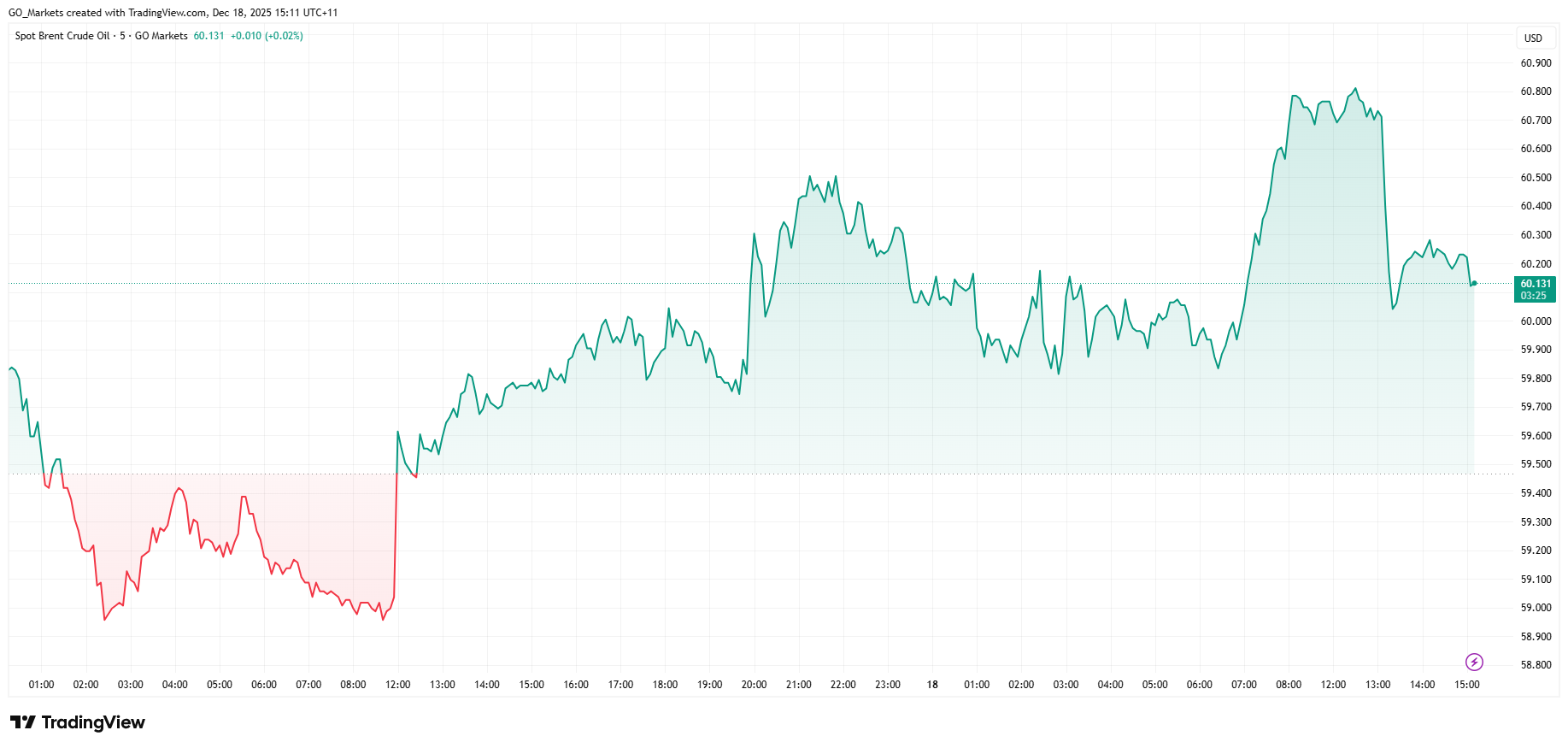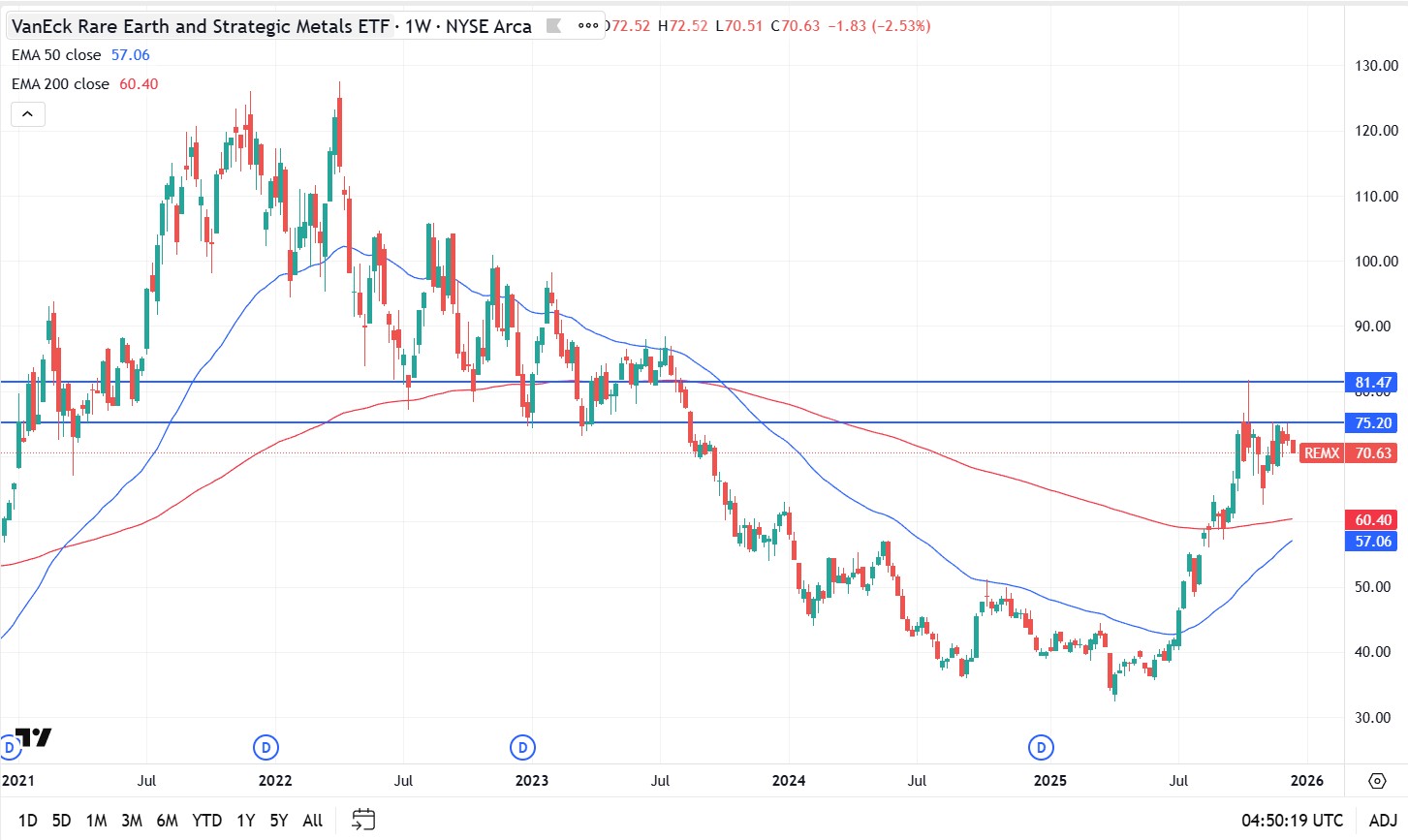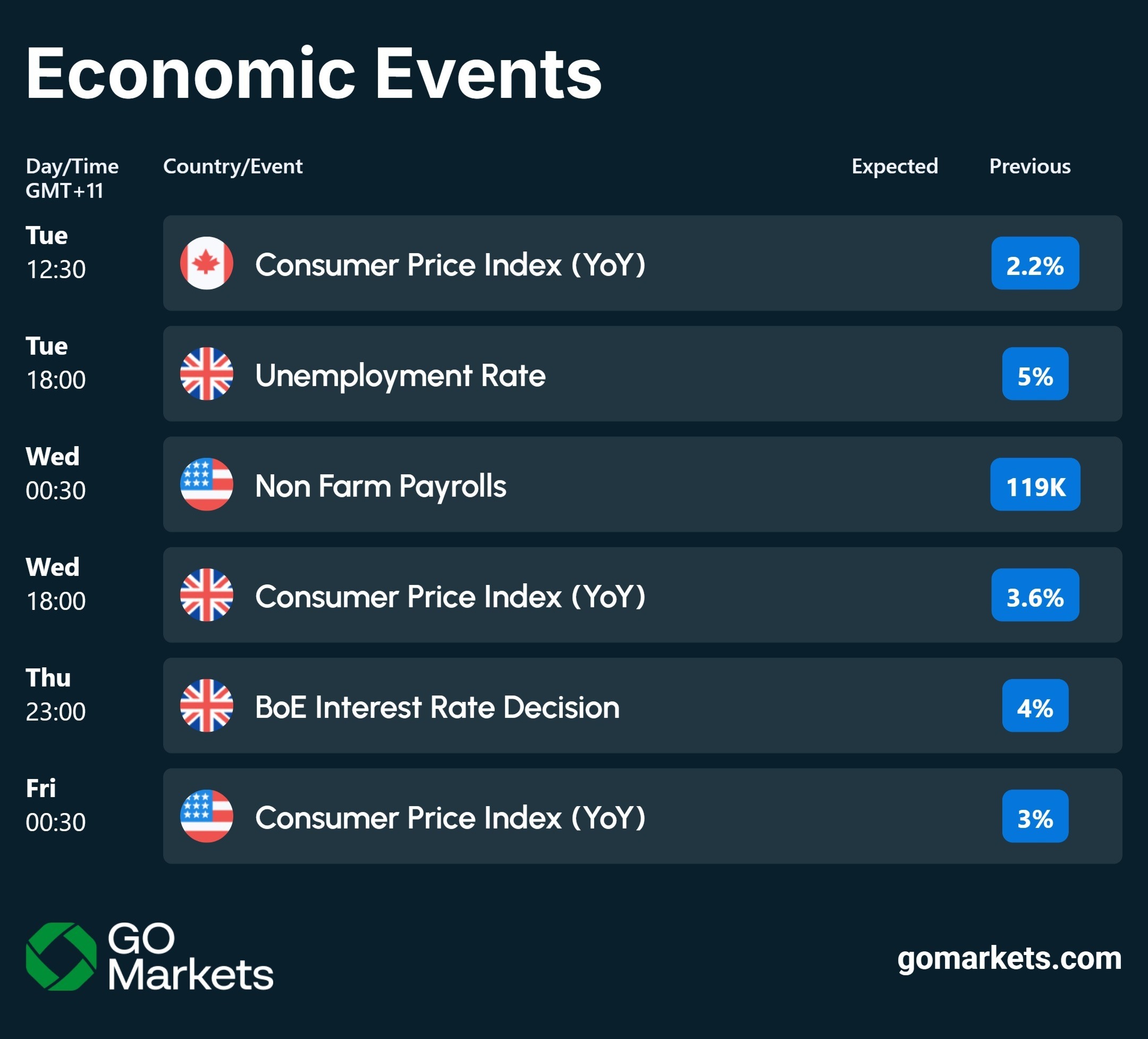市场资讯及洞察

Donald Trump has officially declared the Maduro regime in Venezuela a foreign terrorist organisation and ordered a "total and complete blockade" of the country's sanctioned oil tankers.
The U.S. has positioned 11 warships in the Caribbean to enforce the blockade, which could remove 400,000 to 500,000 barrels daily from global supply.
The move sent crude prices jumping over 2% and sparked renewed concerns about supply stability heading into 2026.

White House Chief of Staff Susie Wiles succinctly summarised the situation as: “Trump wants to keep on blowing boats up until Maduro cries uncle."
Brent crude jumped 2.4% to $60.33 per barrel, while WTI climbed 2.6% to $56.69.
If crude maintains its $60 per barrel price, analysts project the blockade, combined with potential Russian sanctions, could push prices toward $70 as Venezuela's already-devastated economy faces collapse.
Bank of Japan to Hike Rates to Highest Level in Decades
The Bank of Japan is set to raise interest rates to their highest level in three decades this Friday, with Governor Kazuo Ueda expected to lift the benchmark rate from 0.5% to 0.75%.
While modest by global standards, this marks a landmark step in Japan's departure from decades of near-zero rates and unconventional easing.
The decision comes amid significant market turbulence. Japanese government bond yields have surged, with 30-year bonds hitting record highs and 10-year yields reaching 19-year peaks.
The volatility stems partly from concerns under new Prime Minister Sanae Takaichi, who recently approved a $118 billion stimulus package with over 60% financed through borrowing.

While Friday's hike appears certain, policymakers have signalled caution as they push rates toward levels estimated between 1% and 2.5%.
Ueda's post-meeting press conference will be closely watched for signals about future increases.
Micron Forecasts Blowout Earnings on Booming AI Market
Micron Technology is projecting second-quarter earnings of $8.42 per share, nearly double Wall Street's $4.78 estimate.
Micron shares surged 7% in after-hours trading as markets reacted to the news that the AI-driven memory chip race is showing no signs of slowing.

As one of only three major suppliers of high-bandwidth memory (HBM) chips alongside SK Hynix and Samsung, Micron sits at a chokepoint in AI infrastructure.
The HBM specialised chips are essential for training and deploying generative AI models, and current demand is dramatically outpacing supply.
CEO Sanjay Mehrotra revealed that supply tightness will extend beyond 2026, with Micron expecting to fulfil only 50-70% of key customer demand in the medium term.
Micron projects revenue of $18.70 billion this quarter versus analyst estimates of $14.20 billion. The company has retooled their operations toward AI applications, even dissolving its consumer "Crucial" brand to concentrate on AI data centre demand.
HBM chips are now the bottleneck in AI system performance, and suppliers who can deliver at scale have the potential to capture large amounts of value over the coming years.


过去两年,贵金属市场给了投资者一堂非常生动的课。黄金一路新高,白银先按兵不动、再突然加速,走势看似分化,背后却是一条逐渐清晰的主线:一个是货币信用的锚,一个是新一轮工业周期的放大器。
如果说黄金解决的是对未来不确定性的担忧,那么白银正在回答另一个问题:当AI、数据中心、新能源真正进入规模化阶段,哪些资源会成为瓶颈。
答案里,一定有白银。

白银的逻辑,正在从老故事变成新变量
长期以来,白银被视为黄金的影子资产,涨跌节奏更多取决于金银比、货币环境和投机情绪。但这一次不同,工业需求正在成为白银价格中越来越重要的一块拼图。
过去十年,白银需求的核心增长来自三条线:光伏、新能源汽车和电子产业。但在2025年底,市场第一次真正意识到,数据中心和AI,可能才是下一阶段最具爆发力的增量。
从全球数据看,自2000年以来,数据中心数量增长了11倍,但真正夸张的是IT电力容量,从不足1GW提升到接近50GW,增长超过50倍。这意味着什么?意味着单位数据中心里,塞进了越来越多高密度、高算力、高功耗的硬件。
而这些硬件,有一个共同特征:离不开白银。
为什么数据中心离不开白银?
根据世界白银协会最新分析文章,白银并不是因为贵才被用在数据中心,而是因为性能上几乎没有替代品。
第一,导电性。白银是所有金属中导电性最强的,比铜高约6%。在服务器、GPU、交换机这种全年不间断运行的设备里,哪怕损耗降低一个百分点,长期都是巨大的能耗差异。
第二,热导性。数据中心最大的成本之一是散热。白银的高热导性能帮助芯片和电源模块更快把热量导走,降低对复杂液冷系统的依赖。
第三,稳定性和耐腐蚀性。在高负荷、高温环境下,白银能保持连接可靠,延长设备寿命。
具体到应用层面,白银广泛存在于电气触点、银镀连接器、GPU与服务器芯片的封装焊料、热界面材料中。AI算力越密集,这些部件用得越多。
所以,哪怕我们暂时无法精确计算每个数据中心消耗多少克白银,只要知道算力在指数级增长,就足以判断方向。

看白银,开始要盯资本开支
如果说过去看白银,主要看光伏装机、新能源车销量和库存数据,那么现在需要多加两个观察窗口。
一个在北美。Meta、Microsoft、Alphabet、Amazon、Oracle这几家公司的资本开支,是AI算力投资最直接的晴雨表。芯片、服务器、数据中心,本质都是对白银的间接需求。
另一个在中国。华为、阿里、腾讯、百度、美团、京东等公司的AI基础设施投入,同样值得持续跟踪。今年阿里提到的三年数千亿级别AI基建规划,本身就是一个重要信号。
当这些公司的资本开支进入持续高位,白银的工业需求弹性,会比很多人想象得大。
黄金仍是底盘,但节奏会放缓
相比白银的结构性变化,黄金的逻辑其实非常稳定。
长期看,黄金锚定的是美元信用。全球主要经济体债务高企,财政赤字常态化,财政主导逐渐取代货币主导,这是支撑黄金的大背景。央行持续购金,本质上是在对冲主权信用风险。
中期看,黄金仍然受制于美债实际利率。只要实际利率下行,黄金就有空间;反之,上行压力会出现。
展望2026年,一个相对清晰的判断是:黄金不太可能复制过去两年的单边强势。上半年在降息预期和政策惯性下仍有支撑,但下半年随着政治周期、通胀政策调整、风险定价下降,金价更可能进入高位震荡,甚至阶段性回调。
这并不意味着黄金逻辑失效,而是它更适合作为配置资产,而非高弹性博弈工具。
白银与黄金的策略差异
在实际操作层面,黄金和白银的策略应该分开看。
黄金适合的是长期持有和风险对冲。它的作用是压舱石,而不是发动机。越是在宏观不确定性高、资产相关性上升的时候,黄金的价值越明显。
白银则更偏向趋势型和周期型资产。它同时受益于货币环境和工业扩张,但波动远大于黄金。金银比已经从高位明显回落,也提醒投资者,白银进入了更拥挤的阶段。
因此,对白银更合理的策略不是一把梭,而是在趋势确认的前提下,控制仓位、动态调整。尤其是在短期快速上涨后,留足安全边际非常重要。

如果用一句话总结当前的贵金属市场,那就是:黄金稳住底盘,白银开始走向舞台中央。
黄金的故事,是关于信用、制度和长期不确定性;白银的故事,则是关于AI、电力、算力和工业升级。当这两条逻辑在同一个时间窗口共振,贵金属自然会成为资金绕不开的方向。
但舞台再热闹,也需要节奏。接着奏乐接着舞,不代表要一直跳到天亮。看清逻辑,分清角色,控制仓位,可能比单纯判断涨跌更重要。
希望这篇文章,能给你一些有用的参考。


As December 2025 approaches its final trading days, investors are assessing whether seasonal factors may again influence year-end price action.
- The Santa Claus rally has delivered gains in 70 of the past 97 years, but history is no guarantee.
- Technology, retail, and consumer discretionary sectors have historically led with 1.9-2.1 per cent average gains during the Christmas period.
- Recent market rallies, AI weariness, and a hawkish Fed put doubts around the Santa Rally.
The seven-day Santa rally window runs from 24 December through 5 January 2026.
This period has historically outperformed average market conditions, driven by holiday optimism, thin trading volumes, year-end bonus spending, tax-loss completions, and institutional portfolio rebalancing.

5 assets worth watching this Christmas
1. Technology stocks
Technology stocks have historically been standout performers during the Santa rally period, averaging gains of 2.1 per cent across the seven-day window, although results vary significantly year to year.
The Nasdaq Composite typically posts stronger returns than broader indices, with an 82 per cent historical win rate for December-January performance.
However, tech stocks do currently face a challenging setup. The Nasdaq gained 19 per cent year-to-date (YTD) but has come under pressure in recent months, with AI-related stocks experiencing sentiment dips.
Key drivers:
- E-commerce momentum: Black Friday 2025 spending hit a record US$11.8 billion, with sustained demand through December as last-minute purchases drive revenue for Amazon and digital payment processors.
- Holiday infrastructure play: Cloud computing, semiconductors, and digital payments capture the backend of holiday spending surges, benefiting from both retail transactions and year-end enterprise spending.
- Concentration risk: Five companies (Nvidia, Microsoft, Apple, Alphabet, Amazon) account for 30 per cent of major index returns. Down periods for these companies, as seen during recent AI-sentiment-driven volatility, could bring down the sector as a whole.
2. Gold
Gold enters one of its strongest seasonal periods from mid-December through February, having posted gains every year since 2015 during this window.
The gold price is maintaining strength throughout December despite the dollar's resilience, positioning well as the Christmas jewellery season peaks.
Key drivers:
- Seasonal jewellery demand: Approximately two-thirds of annual gold production flows into jewellery fabrication. Christmas, Lunar New Year (February 2026), and the Indian wedding season create regular buying patterns as merchants stock up in December.
- Dollar weakness patterns: December has historically been the dollar's weakest month, with negative bias from 22 December onwards. Gold's inverse correlation to the dollar could provide upside momentum during this period.
- Real yields environment: With the Fed cutting rates to 3.5-3.75 per cent while inflation remains around 3 per cent, real yields stay relatively low, potentially supporting higher gold valuations.
- Central bank accumulation: Continued central bank purchases and year-end institutional portfolio rebalancing could provide additional support.
3. EUR/USD
December has historically been the most bullish month for EUR/USD, with the world's most-traded currency pair posting an average return of +1.2 per cent over the past 50 years.
The US dollar regularly shows clear weakness during the Santa rally period, particularly from 22 December onwards. However, the Fed's hawkish rate cut has provided some dollar support this year.
Key drivers:
- Holiday liquidity dynamics: Lower institutional trading volumes during the holiday period reduce dollar support as retail traders and smaller participants dominate. Thin markets can amplify moves in either direction.
- Year-end rebalancing: European and Asian investors often repatriate funds or rebalance portfolios at year-end, creating demand for non-dollar currencies that typically support EUR and AUD against USD.
- Dollar strength from hawkish Fed: The Fed's December rate cut came with guidance of fewer cuts in 2026. This has kept the dollar elevated despite lower rates, possibly limiting the ability of EUR/USD seasonal patterns to influence the market.
4. Retail stocks
Consumer discretionary and retail stocks historically outperform during the holiday period, with the sector averaging 1.9-2.1 per cent gains during the Santa rally window. Holiday shopping accounts for 30-40 per cent of annual retail revenue for many companies, making this period crucial for full-year performance.
Key drivers:
- Record holiday traffic: A record 202.9 million consumers shopped during the Thanksgiving-Cyber Monday weekend, up from 197 million in 2024. November spending surged 3.8 per cent year-over-year, with total holiday spending projected to exceed US$1 trillion for the first time.
- High-income shoppers trend: Value-oriented retailers (TJX, Five Below) and those with strong omnichannel presence are capturing a disproportionate share of value over retailers targeting low-middle income earners.
- Post-Fed tailwind: The December rate cut provides marginal relief through lower borrowing costs, potentially extending holiday spending into late December as credit becomes more accessible.
5. Bitcoin
Bitcoin's December performance has been highly inconsistent, with a median return of -3.2 per cent, contrasting with traditional Santa rally patterns. Currently, Bitcoin is trading around US$87,500, down approximately 30 per cent from its October all-time high of US$126,210.
However, there are signals that the historically volatile asset could see a Santa-led bounce this year.
Key drivers:
- Institutional infrastructure in place: More than US$120 billion is now held in spot Bitcoin ETFs, which provides a framework that could support capital flows if risk sentiment improves, although inflows are not assured.
- Pro-crypto policy expectations: Discussion around potential developments such as a US strategic Bitcoin reserve and the CLARITY Act could influence sentiment going into 2026, although outcomes remain uncertain.
- Four-year cycle inflection point: The recent sell-off came roughly 18 months after the most recent Bitcoin halving, a point linked to turning points in some past cycles, with the four-year narrative potentially influencing market behaviour.
Risks to watch
- The December Fed meeting delivered a 25 basis point cut, but the hawkish tone has set expectations for fewer rate cuts in 2026.
- The Nasdaq's 19 per cent YTD gain has pushed valuations to elevated levels as AI-stock sentiment begins to dip.
- Five companies account for 30 per cent of index returns, placing portfolio concentration at concerning levels.
- Reduced holiday liquidity amplifies both moves and risks. Thin trading volumes can create exaggerated reactions to headlines, particularly around geopolitical events or economic data.
Is Santa coming to town?
The Santa Claus rally remains one of the better-known seasonal patterns in financial markets, but a historical hit rate of around 72 per cent also implies meaningful years where it does not play out.
A more balanced way to view the Santa rally window is as one input among many.
Seasonal observations can be considered alongside technical levels, fundamental drivers, and risk management — particularly given how quickly sentiment can change in thin holiday conditions.
And, if you can, take time away from the screens and enjoy the break.
.jpg)

12 月中旬,甲骨文公司(Oracle Corporation,NYSE: ORCL)发布了 2026 财年第二季度财报后,其股价在盘前和盘后交易中一度下跌超过 11%–16%,引发投资者广泛关注。作为全球科技和云计算领域的重要企业,由于其作为道指成分股在财报后股价大幅下挫,叠加市场对 AI 投资回报和高资本支出的担忧,成为当日拖累道指表现的重要因素之一。此次股价回调不仅反映了其自身财务表现,也折射出市场对 AI 投资热潮与实际盈利兑现之间的不确定性。
一、财报亮点与业绩数据

在10 日发布的 2026 财年第二季度财报显示:
- 总收入:约 160.6 亿美元,同比增长约 14.2%,但低于华尔街预期的约 162.1 亿美元。
- 非 GAAP 每股收益(EPS):2.26 美元,显著超过市场预期的1.64美元。
- 云收入(IaaS + SaaS):约 80 亿美元,同比增长 约 34%,其中基础设施收入增长 约 68%。
- 软件收入:约 5.9 亿美元,同比下降约 3%,且低于预期。
- 剩余履约义务(RPO):约 5230 亿美元,同比激增 438%,显示公司拥有庞大的订阅合同和未来收入来源。
- 自由现金流:季度内约 -100 亿美元(现金净流出),约为分析师预期的两倍。
这些数据体现出甲骨文在 云业务与 AI 相关收入仍然强劲,业务整体 保持增长态势,但营收整体略低于预期、软件业务下滑、负现金流,而市场更关注的是现金流和成本结构是否可持续,因为增长并不等同于盈利能力的改善。
二、股价下跌的核心原因
甲骨文股价的大幅下跌有多方面因素叠加,主要包括以下几点:
- 营收未达预期
尽管公司收入同比增长 14%,但略低于分析师预测。投资者对 AI 和云业务的预期较高,营收未完全达到预期使市场情绪敏感,短期股价出现明显下滑。尤其是 RPO 合同如何转化为实际收入的不确定性,加剧了市场的谨慎情绪。 - 资本支出激增与现金流承压
甲骨文计划在 AI 数据中心和云基础设施上的投资从约 350 亿美元增加至 500 亿美元,这意味着短期内公司现金流压力显著加大。财报显示本季度自由现金流为 -100 亿美元,远高于市场预期。尽管这些投资旨在支持未来增长,但短期内对资金链稳健性带来压力,引发投资者担忧。 - 传统软件业务增长疲软
与云业务的高速增长相比,传统软件收入下滑明显,且低于预期。这种增长不均衡使市场对公司整体增长能力产生疑虑,投资者担心公司在转型过程中仍存在不确定性。 - 债务与融资风险上升
随着资本支出增加和现金流负值扩大,市场对甲骨文债务水平和融资可持续性更加敏感。信用市场数据显示,公司信用违约掉期价差上升,投资者对潜在杠杆风险和偿债能力产生关注。 - AI 投资热度回落
过去一年,AI 投资热潮推动科技股估值大幅上升,但市场情绪在近期出现分化。虽然甲骨文通过与 OpenAI、Nvidia、Meta 等合作推动 RPO 增长,但市场开始重新评估这些长期合同的兑现速度和成本负担,短期盈利能否兑现存在不确定性。
三、市场反应
股价大幅回调
财报发布后,甲骨文股价迅速下跌,在盘前和盘后交易中一度跌幅达到 11%–16%,成为近年来单次最大幅度的股价回调之一。尽管公司在年内股价曾上涨超过 30%,但自 2025 年 9 月的高点来看,股价已回落约 30%,显示投资者对财报中营收与现金流表现的担忧迅速反映在市场上。
分析师观点分化
对于此次财报,市场分析师意见存在明显分歧。看空的一方认为,营收未达预期显示增长节奏未加快,高额资本支出进一步压缩现金流,同时债务和长期融资的可持续性令人担忧。相反,看多的分析师则强调,巨额 RPO 合同为未来收入提供保障,云业务仍保持稳健增长,而在 AI 领域的投入虽然短期成本较高,但有望在长期形成竞争优势。
行业联动效应
作为科技与云基础设施的龙头企业,甲骨文股价回调也对相关板块产生了一定影响。一些 AI 数据中心运营商和芯片供应商的股价出现波动,部分云计算及半导体企业短期承压。不过,这种联动更多反映了市场对 AI 投资周期的重新定价,而非整个科技板块的系统性下跌。
四、未来预期与潜在关键观察点
短期
- 股价波动可能持续,市场仍将谨慎对待 AI 投资回报和短期盈利路径。
- 投资者将重点关注公司自由现金流改善和运营效率提升,以评估资金链稳健性。
中长期
- RPO 转化为实际营收的速度:若合同兑现速度提速,将大幅增强投资者信心。
- 资本支出效率与盈利增长平衡:若甲骨文能有效控制 CapEx 与提升云业务利润率,估值有望修复。
- 债务与融资结构的稳健性:尤其在利率周期中,利息成本与偿债能力是重要风险考量。
结语:
甲骨文股价大幅下跌,是市场对公司收入表现、资本支出规模及现金流压力之间矛盾的反应。核心问题在于 AI 投资和大规模资本支出能否在中短期内带来足够的收入和现金流改善。虽然公司未来合同量庞大(RPO 超 5000 亿美元),但如何高效转化为实际收入和利润,将决定未来股价走势。
总体来看,此次调整既是对甲骨文自身业绩的现实检验,也是市场对高增长科技股,尤其是 AI 主题投资逻辑的重新评估。未来若公司在收入兑现、资本支出控制及现金流管理上表现出色,将有望在市场重新定价中获得机会。
https://finance.yahoo.com/news/oracle-misses-quarterly-revenue-estimates-215557154.html


REMX approaches key resistance after a sharp rebound
- Instrument: REMX (VanEck Rare Earth and Strategic Metals ETF)
- Time horizon: Short-to-medium term
- Market read: Price action is often interpreted as neutral-to-constructive while holding above the ~$68 area, outcomes remain uncertain
- Chart reference levels: ~$75 (prior reaction/overhead supply area), ~$68 (support area), then ~$81 (next prior reaction area)
Rare earth and strategic metals equities have been among the stronger-performing thematic areas in 2025, though recent price action suggests the rally has paused as investors reassess momentum. REMX has rebounded sharply from its April lows and is now consolidating below a technically significant resistance zone near $75, making it a key level to monitor.
What is REMX?
REMX is an exchange-traded fund that provides diversified exposure to global companies involved in mining, refining, and recycling rare earth and strategic metals. For traders and investors who want sector exposure without relying on a single issuer, the ETF structure can help spread company-specific risk. Performance will still be highly sensitive to commodity cycles and policy/geopolitics.
Portfolio snapshot
The ETF’s larger positions typically include a mix of rare earth producers and lithium-related names. Examples of top holdings (approximate weights, based on the fund’s most recent publicly available holdings data)

Why rare earths and strategic metals matter
Rare earth elements (a group of 17 metals) are not necessarily scarce in the earth’s crust, but economically viable deposits—and especially processing capacity—are concentrated. This creates a supply-chain dynamic where policy decisions, trade restrictions, and downstream demand can have outsized impacts on pricing and sentiment.
Key demand linkages include:
- EVs and wind power (permanent magnets and motors)
- Electronics (speakers, screens, storage)
- Defence/aerospace (guidance, radar, specialised alloys)
- Industrial catalysts (refining and emissions control)
Technical outlook
After marking multi-year lows around $33 in early April, REMX rallied strongly and returned to levels last seen in mid-2023. The $75 area stands out as a prior multi-touch support zone (2021–2023), which increases the probability it acts as resistance on the first approach.
REMX weekly chart

Price has repeatedly tested $75 over the past month without a confirmed breakout. The pattern of higher lows against flat resistance resembles an ascending triangle, often associated with building pressure; however, confirmation requires a decisive break.
REMX daily chart

Scenarios to watch
- Bullish continuation: A daily close above $75 (ideally with expanding participation) would shift focus to $81 as the next resistance zone.
- Range continuation / pullback: Failure to clear $75 again keeps the risk of a retracement toward $68 support.
- Bearish breakdown: A sustained move below $68 would weaken the structure and raise the probability of a deeper mean reversion (next support levels should be mapped from prior swing lows).
.jpg)

US indices pulled back from record highs after the Fed signalled no rate cut in January. The Nasdaq was hit hardest with AI sector anxiety resurfacing.
Combine that with this week's shutdown-delayed jobs data release, and questions are mounting on whether markets can muster a Santa Claus rally this year.
Delayed Jobs Data Could Define Santa Rally
- This week delivers critical economic data that was postponed during the government shutdown:
- Tuesday: Non Farm Payrolls
- Thursday: Consumer Price Index (CPI)
- These two releases could determine whether markets can rally or face further pressure into Christmas.
- Volatility is expected around both announcements as traders position for potential surprises.
ECB and Bank of England Enter Rate Decision Spotlight
- The European Central Bank and Bank of England both announce rate decisions this week.
- EUR and GBP traders should watch closely for any policy divergence that could create currency volatility.
- Cross-border flows may shift as investors weigh different central bank trajectories.
Flash PMI Data Offers Real-Time Economic Pulse Tomorrow
- Tomorrow delivers a global economic snapshot through flash PMI releases from Japan, Australia, Europe, the UK, and the US.
- Markets could react fast to these forward-looking indicators.
- Any regional divergence could signal shifting economic momentum across major markets.
Market Insights
Watch Mike Smith's analysis of the week ahead in markets.
Key Economic Events
Stay up to date with the key economic events for the week.

.jpg)

在过去的一到两周时间里,全球的数字巨头齐聚阿联酋首都阿布扎比,因为伴随着阿布扎比的年度金融周,同时进行了多场数字货币相关的会议与峰会,这场数字行业的“武林大会”其本质目的是为整个数字产业带来更多新的机遇和主权基金的关注,以及更多政策方面最前沿的监管战略方向等。
主要的会议和峰会:

从时间表不难看出这次峰会绝非单一峰会,而是国家级的金融周,无论是规模以及参与的人群和带动的资金导向来看,整个阿联酋世界都将在未来很长一段时间的发展里全力投入于国家新一轮的电子信息化发展,而这中间很重要的一个发展策略便是将整个阿布扎比塑造为新的数字之都,为数字货币的繁荣和发展提供更大的场景和真实的资本支援。
本次大会重要成果
1. Binance在ADGM的完全合规落地本次会议之后Binance将在Abu Dhabi Global Market(ADGM)以及Financial Services Regulatory Authority (FSRA)的监管下拥有三重许可,分别涵盖了,交易所,清算机构,以及经纪/托管业务执照从1月5号开始Binance将可以进行现货衍生品的交易,进行清算托管结算和做市交易等,合规落地算是为整个数字货币交易所开设了先河,之后将会有更多数字货币交易所追随进行牌照注册,同时完善监管体系,吸引更多数字市场的交易人员及投资者,振兴数字市场。具体监管的内容包括:

2. 主权基金和巨头家办与头部数字机构建立资本关系阿布扎比投资机构 MGX 向 Binance 投入稳定币资金 20亿美元, 这笔注资是 历史上最大的一笔针对数字交易所的机构投资,也是 Binance 首次获得机构级投资,并以稳定币支付MGX 背后实力:
- 由 Mubadala (主权财富基金) 与 G42 (AI/科技投资巨头) 联合成立
- 目标管理规模 超过 $1000亿美元资产组合
- 战略聚焦 AI + 区块链 + 高科技领域
巨额机构资本流入对市场的影响包括但不限于增强市场流动性与稳定性,改变市场估值基础,产生巨大的资本协同效应,具体来看将会进一步稳定数字货币市场的价格,同时注入流动性增加市场信心同时引动更多主权基金等大型机构的跟投。3. 阿布扎比将成为全球数字合规中枢阿布扎比本次会议无论是牌照还是注资都将给带来非常重大的影响:
- 让全球的数字监管竞争进入新阶段,成为领先的监管高地,极大的带动人才资本以及规则定权方面的领先优势。
- 大国博弈层面将会在规则和监管强化上拥有更多创新,提升国家在相关领域发展的重要话语权
- 从长期角度进一步重塑经济格局,阿布扎比从上世纪开始便已不断进行产业升级创新,从高科技转型到web3发展,每一步都走在时代的最前沿。
结语:本次数字货币的峰会应该作为数字货币市场的里程碑,因为从监管法制的角度上拉开了新篇章的同时从国家层面和资本层面又给予了极大的支持,这种发展策略或将对阿联酋新时代发展带来更多动力也会给整个数字市场在如今非常大的逆风环境下带来极大的支持和支撑。


